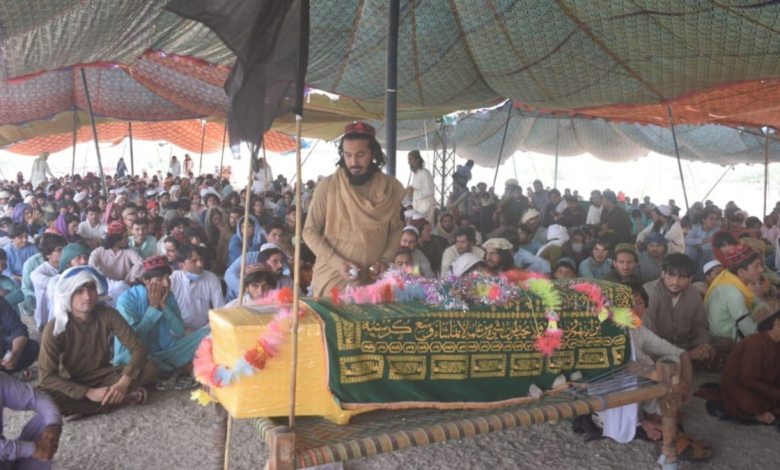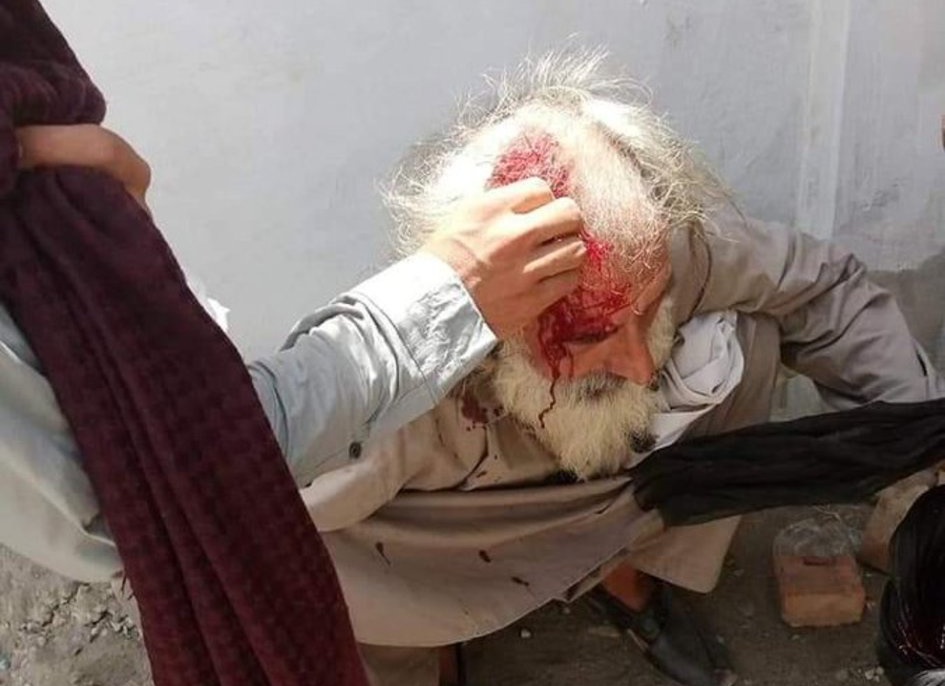The JaniKhel Sit-in: a Nonviolent Protest for Peace in Khyber Pakhtunkhwa, Pakistan
Author: Ilam Khan
The Janikhel, a tribe living in district Bannu of province Khyber Pakhtunkhwa, Pakistan, staged a sit-in on May 31, 2021. The protesters carried the coffin of an elder killed by ‘unknown’ persons and demanded a permanent solution for establishing peace in the region. After 25 days of continuous sit-in and lack of response from the government, the protesters began marching towards Islamabad, the Capital. On their way to Islamabad, the police opened fire on the protestors killing four while wounding some and arresting many others. It was the second sit-in of this tribe who previously staged a sit-in in March 2021 when four Janikhel teenagers were killed by unknown persons and their dead bodies found after five days. After the previous sit-in, an agreement was concluded with the government that also included clauses on establishing peace by clearing the area of terrorists.

The Background
An absence of peace is a fundamental issue in the Pashtun belt of Pakistan, which borders Afghanistan. The Pashtuns have been facing different proxies since the 1980s in this region. In the 1980s, when Soviet Union forces attacked Afghanistan, the USA started a proxy war to counter them for which Pakistan provided land and people. Since then the Pashtun belt of Pakistan became a safe haven for the fighters who were further glorified as “Mujahideen”, the holy fighters. Post 9/11 when the US and its allies attacked Afghanistan these fighters turned against them and were known as the Taliban. The Taliban started mass killings in the region and, in response, the Pakistan military started operations to clear the area of the Taliban terrorists. During these military operations, thousands of tribesmen were killed, multiple infrastructure destroyed, businesses ruined and about 80 percent of the population became internally displaced.
Since 2001, multiple resistive movements of both violent and nonviolent nature have taken place in the Pashtun region. The violent movements were led by the Qaumi Lashkars (civil militias) in different areas who fought bravely against Taliban terrorists and reclaimed their territory. These violent movements became popular in the media and academia as they caused enormous human and property loss.
Nonviolent movements have also sought to end militancy and destruction and establish peace in the region. The Pashtun Tehafuz Movement (PTM) led by Manzoor Pashteen) for instance, came into being by openly criticizing the Pakistan military for being the reason behind the disturbance in the region and protecting the terrorists. The PTM activists are the followers of Bacha Khan’s ideology of ‘Khudai Khidmatgaar’ (servants of God) which was a nonviolent movement against British imperialism. A number of peaceful protests have been held in the Pashtun region since the PTM was established in 2018. Other nonviolent movements led by the Pashtuns include the Youth Jarga (youth council, with the support of security forces) and the movement against FCR[1] (supported by the UNDP). The Janikhel nonviolent movement is different from the other movements as it is based on tribal principles; i.e. in the Pashtun tribal system where in tribe elders take the final decision to accomplish any task and all tribesmen are required to participate in it under any circumstance. Therefore, the tribesmen will continue protesting until the elders decide otherwise.
Janikhel Sit-in June 2021
While the Janikhel tribe in Bannu has been suffering since the launch of the catastrophic war on terror, it was only in March, 2021 when their silence was broken after the murder of the four teenagers. The sit-in of the tribesmen continued for several days alongside the coffins of the four teenagers. Two Pashtun nationalists parties, the Awami National Party (ANP) and Pakhtunkhwa Milli Awami Party (PkMAP), who have been fighting for the cause of the Pashtuns since the formation of Pakistan, also participated in the sit-in. However, it was only after the protesters threatened to carry the dead bodies to Islamabad and began marching towards the Capital on the twelfth day of the protest that the government intervened and the sit-in was called off with an agreement. The agreement included clauses on establishing peace in the area, stoppage of target killing and the clearance of the area from every non-state actor/ terrorist.

The immediate cause of the second sit-in was the killing of Malik Naseeb Khan, who was among the leaders and organizers of the first sit-in. The demands, nevertheless, are the same as in the previous sit-in: the establishment of peace, end to targeted killings and an operation against terrorists’ hide-outs. Before staging this sit-in the Janikhel called a Jarga (council of elders) in which some rules were set: at least one person from every house would participate in the sit-in, those with vehicles would provide it to the protesters, and anyone in the tribe who did not follow these rules would be fined. Both the sit-ins were nonviolent despite the violation of the agreement by the government and the absence of visit by any governmental official even after the 27th day of the sit-in. Likewise, no political party or civil society was allowed to participate in the sit-in and the roads leading to the sit-in were blocked by the state security forces discouraging any coverage by the media of the killing, the protest or the sit-in. During the previous sit-in it was only after the protesters began marching towards Islamabad that the Chief Minister of the province visited the site for negotiations and concluded an agreement. The protestors adopted a similar strategy in the second sit-in and began marching towards Islamabad. A government representative negotiated with the protesters on the third day of the march and the protestors called off the protest after the government provided assurance of fulfillment of their demands within a month. The agreement also mentioned that deceased protesters will receive 2.2 million Pakistani rupees and the government will also compensate for other material loss.
Dr. Gul Alam, a leader of the protest, speaking to a local journalist stated that the protesters have contacted all Pashtun political parties (both religious and secular ) for a grand Jarga of all Pashtun political and social activists to decide upon the future course for Pashtuns who have been facing proxies since the last forty years which has killed over 70 thousands Pashtuns while also causing immense economic loss in the region. All Pashtun politicians have agreed to hold this Jarga after three months from today (as of July 2021). This is an alarming announcement for the government of Pakistan because one of the demands of the PTM is the formation of Truth and Reconciliation Commission (TRC) which could inquire about the losses faced by the Pashtuns during the war on terror. If demand for TRC is raised in the Jarga of all Pashtuns political parties, then the state cannot resist the demand. And the formation of the TRC could disclose the proxies of the state which will definitely widen the gap between the state and Pashtuns in Pakistan.
Protesters’ point of view
A prevalent understanding among the protestors and the PTM was that the Pakistani state does not want any media coverage of the protest and seeks to keep its activities hidden from the rest of the country as well as the international community because it sponsors terrorism. One protester argued that all political parties and human rights groups should participate in the sit-in as it seeks durable peace in the region. “However, as the government is titular it does not have the power to fulfill the demands of the sit-in. The real power lies with the Pakistan Army which does not want to end these proxies on our land.”

The protestors’ refusal to bury the dead body was a strategy to gain mass support as the dead are considered sacred in Pashtun society. This strategy was successful to a large extent due to the participation of different Pashtun political and social activists. Even so, only two members of nationalists’ political parties, Mohsin Dawar of the PTM, in the national assembly and Sardar Babak of ANP in the provincial assembly, mentioned the sit-in.
Significance of the Janikhel sit-in
The 30 days long Janikhel sit-in and march towards the Capital ended after the government assured protesters that their demands would be fulfilled and another agreement would be concluded after a month. During the 30 days of sit-in and the march, the government applied every strategy to end this protest: blocked roads, fired bullets, shelled tear gas, and arrested protesters. Yet, the nonviolent nature of the protest compelled the government to negotiate. This is significant because, while nonviolent movements have a long history among the Pashtuns, violent protests took over due to the Pakistani state’s policies of proxy wars, penetration of violent groups into the Pashtun region and the popularity of Kalashnikov culture since the Afghan war in the 1980s. The violent response to terrorists in post 9/11 was a failure in which thousands of tribesmen lost their lives. This violent approach in the form of civil militia took a nonviolent turn when the PTM was formed in 2018. Since then, a number of successful nonviolent protests have been staged by the Pashtuns including the two successful protests of the Janikhel tribe. There is no example in Pashtun land where a violent action has achieved the goal(s) where the Janikhel protest can be presented as a good example of nonviolent action. Another positive aspect of the protest is that it provided a sense of unity among the Pashtuns and a number of Pashtuns from other tribes also participated in it. It also helped other Pashtun tribes realize that if such happenings occur they can stage similar protests and force the government to change its policies. The protest also holds a lesson for the state of Pakistan: policies that encourage proxies no longer work and people will protest against them. Furthermore, proxy approaches will widen the gap between the citizen and the state as well as reduce citizens’ trust upon government institutions which is a required element for statehood.
[1] Frontier Crimes Regulations (FCR), also known as black law, was implemented by the then British in 1901 and abolished by the government of Pakistan through a constitutional amendment in 2018.
The views and opinions expressed in the piece above are solely those of the original author(s) and contributor(s). They do not necessarily represent the views of Centre for Social Change.

Mr. Ilam Khan is an ethnographer and has extensively studied the post-conflict environment in Khyber Pashtunkhwa, Pakistan. He is a research associate at NUST, Islamabad.
©2021 Centre for Social Change, Kathmandu

4 Responses
We are the worst people of the world and the best promoter for the peace. We are demanding peace and humble. The JANIKHAIL accedent prove That the state is not intersted to have peace in KP
May be the pakhtoon origin of the author prevents him from having a balanced and unbiased approach. PTM is unpopular in Pakistan because of its anti-state agenda and open criticism of pak military.
The article thoroughly highlighted nonviolent movements and their role in pushtun society to provide background. The good and bad has been harassing the janikhel tribe for years. The government is reluctant to take strict action against the miscreants and the present deal will meet the same fate as of the previous one. The govt failed to arrest the killers of the 4 young boys and an elder, that raises questions on the performance of govt institutions.
One more thing the PTM activists r not necessarily the followers of Bacha Khan as they come from various political background. The movement adopted (and inspired by) Bacha Khan non violent strategy.
So Bacha Khan non violent strategy is revitalise by the PTM.
A nice piece written by Dr Ilam Khan on the subject. It revealed so many things. Merged areas of erstwhile FATA are going through a transformation, and it will continue for some time. It is unfortunate that the recent social change will bear us some cost, both in terms of monetary, and human lives. I hope the region sees sustained prosperity just like other settled areas in the country.